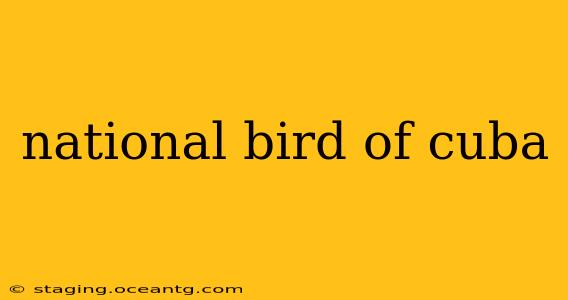Cuba, the vibrant island nation in the Caribbean, boasts a rich history and culture reflected even in its national symbols. Among these, the national bird, the tocororo ( Priotelus temnurus), holds a particularly significant place. More than just a pretty bird, the tocororo embodies the spirit of Cuban identity, representing its unique blend of pride, resilience, and natural beauty. This article delves into the fascinating story of this iconic bird, exploring its distinctive characteristics, cultural significance, and conservation status.
What is the National Bird of Cuba?
The tocororo is a medium-sized bird, measuring approximately 25 centimeters in length. Its striking plumage is a breathtaking mix of colors: a vibrant emerald green back, a bright red belly, black wings, and a distinctive white patch on its tail. This stunning combination of colors is believed to mirror the colors of the Cuban flag, further enhancing its symbolic importance. The male and female tocororos are virtually indistinguishable in appearance.
Why is the Tocororo the National Bird of Cuba?
The tocororo's selection as Cuba's national bird isn't arbitrary; it's deeply rooted in the nation's history and cultural values. Its striking plumage, mirroring the colors of the Cuban flag, immediately connects it to national identity. But beyond its visual appeal, the tocororo's behavior further cements its status as a powerful symbol.
Unlike many birds that flee from danger, the tocororo is known to remain remarkably calm and even seemingly unafraid. This unwavering nature has been interpreted as representing the unwavering spirit and resilience of the Cuban people in the face of adversity. This steadfastness is a powerful symbol of national pride.
What Makes the Tocororo Unique?
Beyond its symbolism, the tocororo possesses several unique characteristics that set it apart:
- Endemic Species: The tocororo is endemic to Cuba, meaning it's found nowhere else in the world. This further strengthens its association with the island's unique biodiversity and environmental heritage.
- Dietary Habits: These birds primarily feed on insects, fruits, and nectar, playing a vital role in the island’s ecosystem.
- Vocalizations: The tocororo’s distinctive call is a melodic sound, adding to its overall charm and symbolic importance.
- Habitat: The tocororo thrives in diverse Cuban habitats, from forests to gardens, highlighting its adaptability and resilience.
Is the Tocororo Endangered?
While not currently considered critically endangered, the tocororo faces threats to its population. Habitat loss due to deforestation and agricultural expansion poses a significant challenge. Furthermore, climate change and the illegal pet trade also impact its survival. Conservation efforts are crucial to ensure the long-term survival of this iconic bird and protect Cuba's rich biodiversity.
What are the threats to the Tocororo population?
As mentioned earlier, habitat loss is the primary threat. Deforestation and unsustainable agricultural practices are shrinking the tocororo's natural habitat, limiting its ability to thrive and reproduce. The illegal wildlife trade also poses a significant risk.
What is being done to protect the Tocororo?
Several conservation organizations and government initiatives are dedicated to protecting the tocororo. These efforts include habitat restoration projects, public awareness campaigns, and stricter enforcement of anti-poaching laws. The ongoing monitoring of tocororo populations also provides crucial data for effective conservation strategies.
What other birds are native to Cuba?
Cuba boasts a remarkable array of avian species, many of which are endemic. These include the Cuban parrot, the Cuban tody, the Cuban trogon, and various species of hummingbirds, each playing an important role in the island's ecosystem.
The tocororo's vibrant plumage and unwavering spirit make it a truly fitting symbol for Cuba. Its continued survival is vital not only for preserving Cuba’s biodiversity but also for safeguarding a powerful symbol of national identity and resilience. Continued conservation efforts are essential to ensure this iconic bird continues to grace the island for generations to come.
